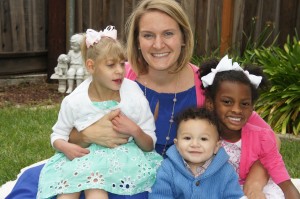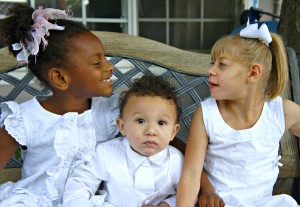
She drove home, crying and devastated, after a doctor advised her not to have any more children.
Her only daughter, then three months old, had just been diagnosed with a rare genetic disease.
Jenny Greene spoke of her feelings at the time. “We always thought we were going to have a big family, so on the car ride I was crying, and then my husband said, ‘Well, Jenny, let’s just adopt.” And I was like, ‘Yeah!’”
When the time came to adopt a child, the Greene family sought help from LDS Family Services. During the adoption process, the couple was asked whether or not they would be willing to adopt a child of a different race. Now, several years later, the Greenes are parents of three children, two of which are adopted: one black and one half-Hispanic.
Checking “yes” to adopting a child of a different race was very natural for Greene, but she recognizes it may not be the case for everyone. Many parents have concerns about how the child will fit in with their other children and how the child will feel about his or her identity.
Dr. Chris Crowe, an English professor at BYU and friend to Greene, said he was not expecting some of the challenges his adopted children would ultimately face.
“Our view was, ‘They’re our children,’ and so we weren’t looking for problems,” Crowe said. “We were oblivious. I know when they got into high school they might have felt like they were on the outside because they were a different race from their peers. They’ve never articulated those things, but I could sense it from watching them.”

Crystal Jewkes, an adjunct professor at BYU, teaches multi-cultural education for secondary students. Jewkes is also the adoptive mother of children of a different race, and her story demonstrates that the challenges associated with transracial adoption can start young.
Jewkes summarizes her adopted children’s desires as “not wanting to stick out.”
“My daughter doesn’t want to be different from me,” Jewkes said. “She’ll say things like, ‘I want hair like yours,’ or in the winter time when her skin is lighter she’ll say, ‘Look, Mom, our skin is the same color!’”
Jewkes went on to describe a time when her daughter told her that her friend would not let her play a game with her because her skin wasn’t light enough.
Despite its challenges, 40 percent of all adoptions in the U.S. are transracial, according to the National Survey of Adoptive Parents. According to Jewkes, raising a transracial family is no different from what she teaches in her class and what the gospel teaches about raising families.
“It’s not a new concept. Have lots of family time, a lot of turning-the-TV-off time, a lot of communication with each other and a lot of spending time together,” she said. “Adjust the issues as they come. They just want to feel normal. They just want to feel like they belong,” Jewkes said.
Noting that she might be starting up the adoption process again herself, Greene said that, ultimately, the perspective the gospel provides has helped her through the process. “We feel like Heavenly Father is very involved in our personal lives and very aware of our family and who needs to come into our family,” she said. “We don’t seek out any specific kind of adoption; we just seek out our kids.”




